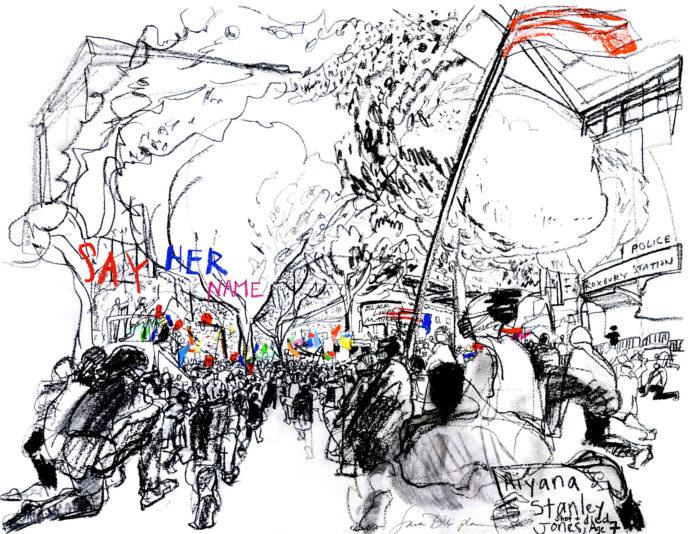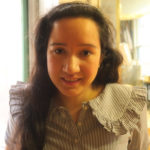
“The role of art is to continue to show that out of pain comes beauty.”
When student Anthony Araujo-Amaral received a phone call from his art mentor, David Fichter, asking him if he wanted to participate in making art for Black Lives Matter protests, he knew that the work they created could reflect the perspective of the movement. Several weeks ago, Fichter recruited young artists to join him in his studio to design vibrant paintings and portraits, believing that the protests could use some more dynamic visual language.
“David supplied us with foam core, which is very lightweight, but it’s also very durable, in case it would rain. We used acrylic paint, and I used my computer to look up some references,” said Araujo-Amaral. “I put a quote on the back, ‘You can jail a revolutionary, but you can’t jail the revolution.’”
Araujo-Amaral and the other artists commemorated Black lives lost to hate crimes and police brutality, depicting figures such as Mubarak Soulemane, Breonna Taylor, and Tamir Rice. One painting, created by Araujo-Amaral, represented a personal hero of his, Fred Hampton, a Black Panther who was killed by police in 1969. The artists carried their work at several demonstrations, including one at Cambridge Common, a rally led by Beyond New Perspectives, and protests held outside Whole Foods. Araujo-Amaral said that he was driven to create paintings when he heard about the injustice of police responding to protests with more brutality. He hoped to draw parallels between the work of the Panthers, beginning in the 60s, and the movement taking place today.
“I wanted to connect their need for a just and equitable society, free from economic, social, and political exploitation, the porous layers of society, from the rich and powerful, and also the people who enforce the laws, the police and the military. That need is greater than ever,” said Araujo-Amaral.
Art has played a powerful role in the Black Lives Matter movement, as many protests have incorporated poetry, dance, and visual elements into demonstrations. Xerxes Butt, another student artist who worked with Fichter, said that she hopes creating public art will draw communities together. Fichter said that art can bring a level of humanity to the protests, helping people to feel more emotionally connected to the experience. By portraying figures whose lives have been lost, victims of violence can be remembered and honored for all time.
“It condenses the energy and the feelings to a more emotional, visual form,” said Fichter. “We’ve chosen to paint larger-scale portraits. It takes these images that we see in the press and condenses it in a real emotional form that people easily grasp and connect with, sort of like music does. When people sing, you are connected in an empathetic way. They’re not just a name of somebody who lost their life in this awful experience. They’re also larger than life, in a way.”
Karlene Griffiths Sekou, an organizer from Black Lives Matter Boston and the visionary behind the July 4 Say Her Name march, said that art intentionally played a prominent part in the demonstration. The rally was planned to celebrate the lives of Black women and incorporated poetry, dance, visual art, and music. As an organizer, Griffiths Sekou saw an opportunity for creativity and imagination, hoping that the presence of art would serve as an expression of culture, steeped in ritual and lyricism. Poet Ashley-Rose Salomon performed two original works, “America’s Dried Up Well” and “The Haunting,” while artist Cicely Carew designed a colorful banner that represented Black women whose lives were tragically taken. Griffiths Sekou said that art has the capacity to be transcendent and enriches the protest movement.
“I think the role of art is to speak. The role of art is to testify and expand our sense of who we are, our sense of the possible. …I think we can all come together and sing songs of hope, lament, protest, and rage, because in a sense, it knits our humanity together,” said Griffiths Sekou.
Other artists, like Sara Dilliplane, have been capturing the essence of the protests by sketching them on location. Streaks of charcoal depict the signs participants carried, while bursts of color interjected on the page convey the energy and vitality of the movement. Dilliplane has been drawing rallies for years, but she said that the passion she witnessed at the Black Lives Matter marches has been unique.
“The momentum behind this one is very powerful and very specific,” said Dilliplane, who brings her materials on site to sketch, drawing in the midst of the protests. “The main experience that we have as artists as opposed to a photographer is that when you’re drawing, you really get a sense of the emotion, and you’re able to physically, on the spot, communicate that through whatever medium you’re using, color, or line, or graphics, or texture.”
The Say Her Name march also featured the poetry of Carla Sheffield, whose son Burrell Ramsey White was killed by police in 2012. She performed the poem “Hey, Officer,” which questioned how she should tell her daughter to trust the police. In the aftermath of her son’s death, Sheffield began writing as a way of processing her grief, directing her emotions towards a creative outlet.
“Losing my son brought out the artistry I didn’t know I had in me,” said Sheffield.
Art contributes to the life of the movement, said Griffiths Sekou, as it serves as a voice and represents a perception. Bringing a feeling to the protests where they debut, the artworks open conversation and carry new questions into consciousness.
“To intentionally build a movement, it takes everything, for those who are organizers, for those who choose to be active,” said Griffiths Sekou. “It takes vision and creativity and imagination. … The role of art is to tell that story, to continue to make legible the good, the bad, and the ugly. It’s to make legible stories that have often been denied, erased, hidden, or opposed. The role of art is to continue to do that and to show that out of pain comes beauty.”
Shira Laucharoen is a reporter based in Boston. She currently serves as the assistant director of the Boston Institute for Nonprofit Journalism. In the past she has written for Sampan newspaper, The Somerville Times, Scout Magazine, Boston Magazine, and WBUR.

